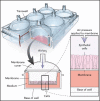Putting the Squeeze on Airway Epithelia
- PMID: 26136543
- PMCID: PMC4888965
- DOI: 10.1152/physiol.00004.2015
Putting the Squeeze on Airway Epithelia
Abstract
Asthma is characterized by chronic inflammation, airway hyperresponsiveness, and progressive airway remodeling. The airway epithelium is known to play a critical role in the initiation and perpetuation of these processes. Here, we review how excessive epithelial stress generated by bronchoconstriction is sufficient to induce airway remodeling, even in the absence of inflammatory cells.
©2015 Int. Union Physiol. Sci./Am. Physiol. Soc.
Conflict of interest statement
No conflicts of interest, financial or otherwise, are declared by the author(s).
Figures




Similar articles
-
Cell Jamming in the Airway Epithelium.Ann Am Thorac Soc. 2016 Mar;13 Suppl 1(Suppl 1):S64-7. doi: 10.1513/AnnalsATS.201507-476MG. Ann Am Thorac Soc. 2016. PMID: 27027955 Free PMC article. Review.
-
Mechanisms of airway remodeling.Chest. 2013 Sep;144(3):1026-1032. doi: 10.1378/chest.12-3073. Chest. 2013. PMID: 24008953 Review.
-
Critical role of actin-associated proteins in smooth muscle contraction, cell proliferation, airway hyperresponsiveness and airway remodeling.Respir Res. 2015 Oct 30;16:134. doi: 10.1186/s12931-015-0296-1. Respir Res. 2015. PMID: 26517982 Free PMC article. Review.
-
Increased expression of cathepsin C in airway epithelia exacerbates airway remodeling in asthma.JCI Insight. 2024 Nov 22;9(22):e181219. doi: 10.1172/jci.insight.181219. JCI Insight. 2024. PMID: 39436705 Free PMC article.
-
Bronchoconstriction: a potential missing link in airway remodelling.Open Biol. 2020 Dec;10(12):200254. doi: 10.1098/rsob.200254. Epub 2020 Dec 2. Open Biol. 2020. PMID: 33259745 Free PMC article. Review.
Cited by
-
Plasminogen activator inhibitor-1 is elevated in patients with COPD independent of metabolic and cardiovascular function.Int J Chron Obstruct Pulmon Dis. 2017 Mar 22;12:981-987. doi: 10.2147/COPD.S128689. eCollection 2017. Int J Chron Obstruct Pulmon Dis. 2017. PMID: 28356730 Free PMC article.
-
Cellular Biomechanics in Drug Screening and Evaluation: Mechanopharmacology.Trends Pharmacol Sci. 2016 Feb;37(2):87-100. doi: 10.1016/j.tips.2015.10.005. Epub 2015 Dec 1. Trends Pharmacol Sci. 2016. PMID: 26651416 Free PMC article. Review.
-
Integrating mechanical cues with engineered platforms to explore cardiopulmonary development and disease.iScience. 2023 Nov 15;26(12):108472. doi: 10.1016/j.isci.2023.108472. eCollection 2023 Dec 15. iScience. 2023. PMID: 38077130 Free PMC article. Review.
-
Collective migration and cell jamming in asthma, cancer and development.J Cell Sci. 2016 Sep 15;129(18):3375-83. doi: 10.1242/jcs.187922. Epub 2016 Aug 22. J Cell Sci. 2016. PMID: 27550520 Free PMC article. Review.
-
Soft robotic constrictor for in vitro modeling of dynamic tissue compression.Sci Rep. 2021 Aug 13;11(1):16478. doi: 10.1038/s41598-021-94769-2. Sci Rep. 2021. PMID: 34389738 Free PMC article.
References
-
- Atherton HC, Jones G, Danahay H. IL-13-induced changes in the goblet cell density of human bronchial epithelial cell cultures: MAP kinase and phosphatidylinositol 3-kinase regulation. Am J Physiol Lung Cell Mol Physiol 285: L730–L739, 2003. - PubMed
-
- Bara I, Ozier A, Girodet PO, Carvalho G, Cattiaux J, Begueret H, Thumerel M, Ousova O, Kolbeck R, Coyle AJ, Woods J, Tunon de Lara JM, Marthan R, Berger P. Role of YKL-40 in bronchial smooth muscle remodeling in asthma. Am J Respir Crit Care Med 185: 715–722, 2012. - PubMed
-
- Bi D, Zhang J, Chakraborty B, Behringer RP. Jamming by shear. Nature 480: 355–358, 2011. - PubMed
Publication types
MeSH terms
Grants and funding
LinkOut - more resources
Full Text Sources
Other Literature Sources
Medical

